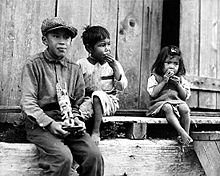- Nuu-Chah-Nulth
-
Nootkas
 Pour les articles homonymes, voir Nootka.
Pour les articles homonymes, voir Nootka.Nootkas
Nuu-chah-nulth
Enfants nootkas, années 1930 Populations significatives par régions  Canada
Canada8 147[2] Population totale 8 147[2] Langue(s) Anglais, nootka Religion(s) Les Nootkas ou Nuu-chah-nulth sont des Amérindiens vivant sur la côte occidentale du Canada. L'expression Nuu-chah-nulth est utilisée pour désigner 15 nations du Pacifique Nord-Ouest. Par contre, l'expression "Nootkas" est depuis quelques décennies considérée incorrecte, étant une désignation donnée au peuple Nuu-chah-nulth en erreur par l'explorateur britannique James Cook quand les Nuu-chah-nulth voulait lui indiquer qu'il pouvait naviguer autour ("nootka") le havre où ils habitaient. Cook prit l'expression pour le nom du peuple eux-mêmes.[3]
A l'époque précolombienne, leur population était plus nombreuse, mais elle a été par la suite décimée par les épidémies ou intégrée à d'autres groupes voisins. Les Nootkas sont proches des Chinook et des Kwakiutl. La langue Nuu-chah-nulth fait partie du groupe des langues wakashanes. Comme les autres peuples de cette région, les Nootkas sont connus pour les cérémonies du potlatch, pendant laquelle on s'échange des cadeaux. D'ailleurs, le terme 'potlatch' vient de la langue nuu-chah-nulth.
En tant qu'habitants de Nootka Sound, où les Espagnoles s'installèrent Fort San Miguel, le seul post espagnol dans la territoire de ce qui deviendrait le Canada, les Nuu-chah-nulth jouèrent un rôle préeminent aux années 1770 jusqu'aux années 1790 dans les conflits entres les Espagnoles, les Britanniques et les Américains pour le contrôle de l'Île de Vancouver et la traite des fourrures. En 1792 le chef Maquinna accueillit des délégués espagnols (menés par Juan Francisco de la Bodega y Quadra) et britanniques (sous la direction de George Vancouver) au Convention de Nootka (Nootka Convention) qui eut lieu à San Miguel.
Sommaire
Notes et références
Bibliographie
- Ellis, David, W.; & Swan, Luke. (1981). Teachings of the tides: Uses of marine invertebrates by the Manhousat people. Nanaimo, British Columbia: Theytus Books.
- Hoover, Alan L. (Ed.). (2002). Nuu-chah-nulth voices: Histories, objects & journeys. Victoria, B. C.: Royal British Columbia Museum.
- Kim, Eun-Sook. (2003). Theoretical issues in Nuu-chah-nulth phonology and morphology. (Doctoral dissertation, The University of British Columbia, Department of Linguistics).
- McMillian, Alan D. (1999). Since the time of the transformers: The ancient heritage of Nuu-chah-nulth, Ditidaht, and Makah. Vancouver: UBC Press.
- Sapir, Edward. (1938). Glottalized continuants in Navaho, Nootka, and Kwakiutl (with a note on Indo-European). Language, 14, 248-274.
- Sapir, Edward; & Swadesh, Morris. (1939). Nootka texts: Tales and ethnological narratives with grammatical notes and lexical materials. Philadelphia: Linguistic Society of America.
- Sapir, Edward; & Swadesh, Morris. (1955). Native accounts of Nootka ethnography. Publication of the Indiana University Research Center in Anthropology, Folklore, and Linguistics (No. 1); International journal of American linguistics (Vol. 21, No. 4, Pt. 2). Bloomington: Indiana University, Research Center in Anthropology, Folklore, and Linguistics. (Reprinted 1978 in New York: AMS Press, ISBN 0-404-11892-5).
- Shank, Scott; & Wilson, Ian. (2000). Acoustic evidence for ʕ as a glottalized pharyngeal glide in Nuu-chah-nulth. In S. Gessner & S. Oh (Eds.), Proceedings of the 35th International Conference on Salish and Neighboring Languages (pp. 185-197). UBC working papers is linguistics (Vol. 3).
Voir aussi
Articles connexes
Liens externes
- Portail de la Colombie-Britannique
Catégories : Peuple amérindien de la Colombie-Britannique | Autochtone du Canada | Groupe ethnique du Canada
Wikimedia Foundation. 2010.

